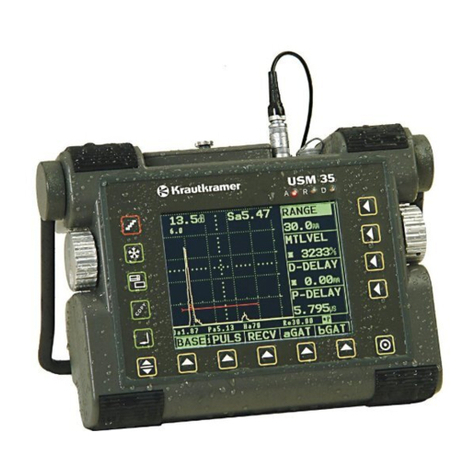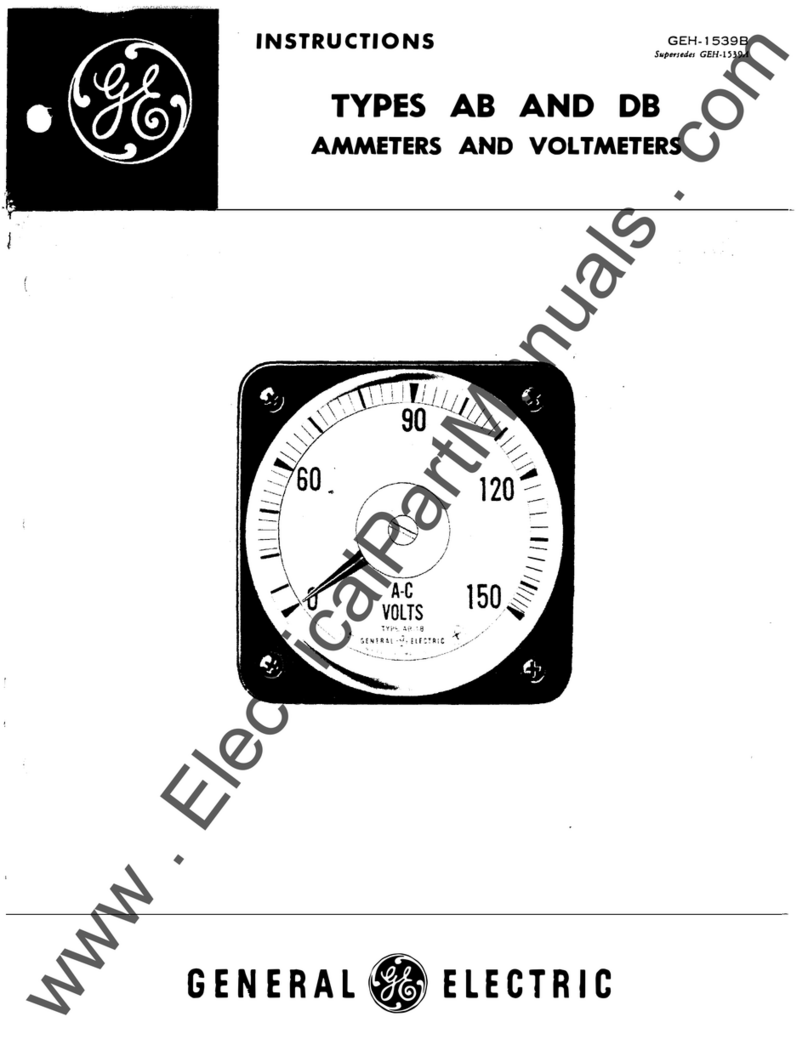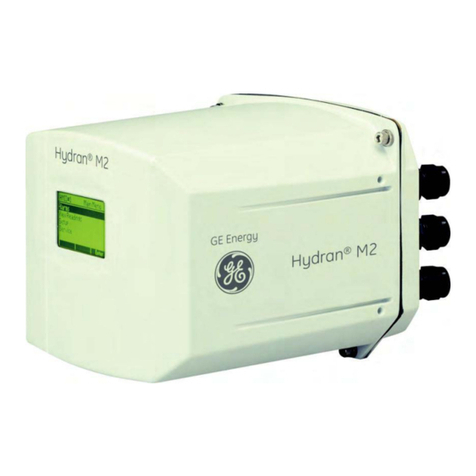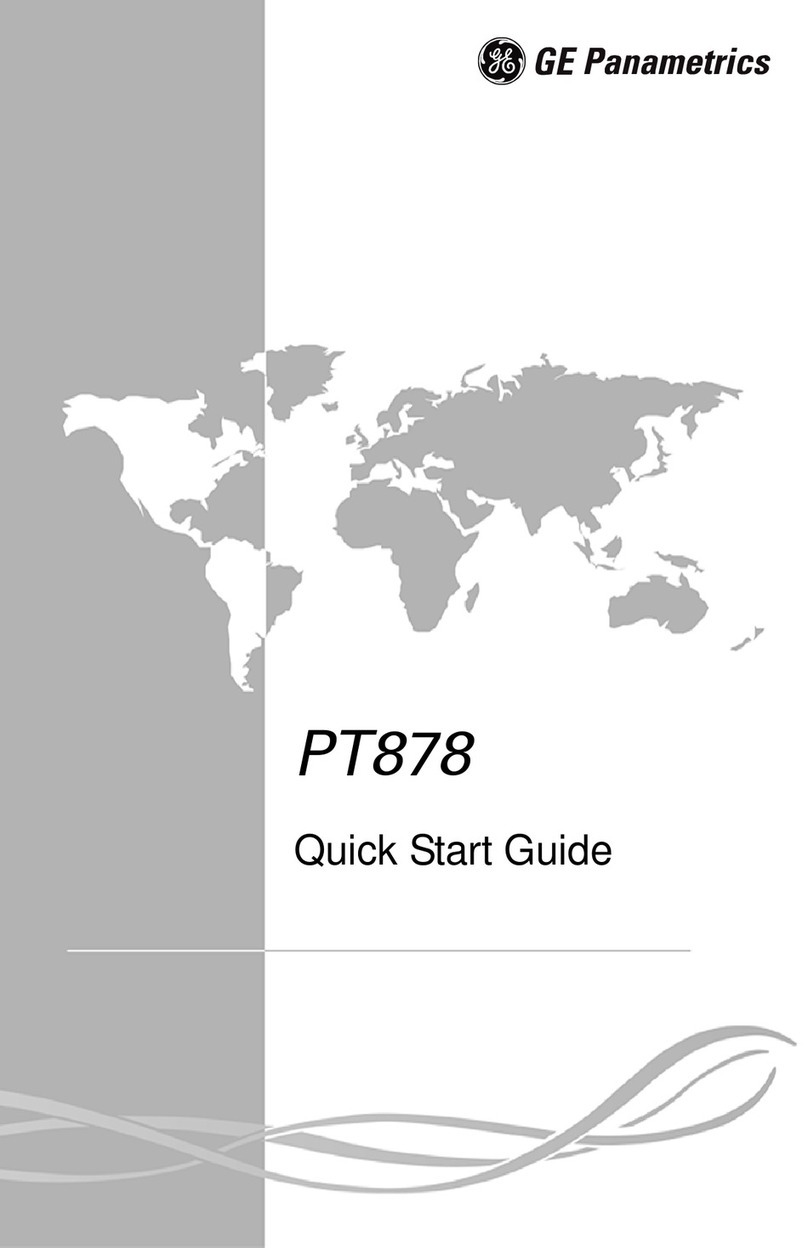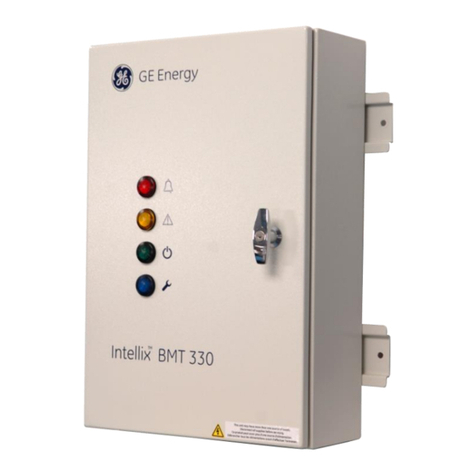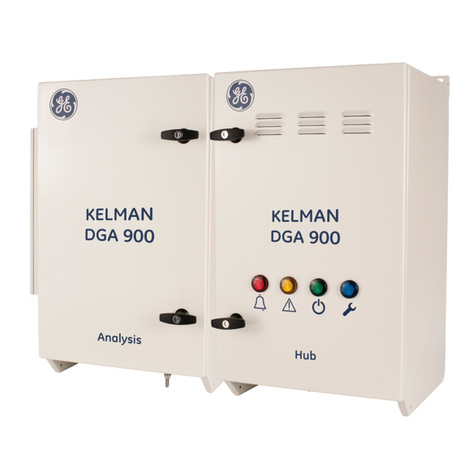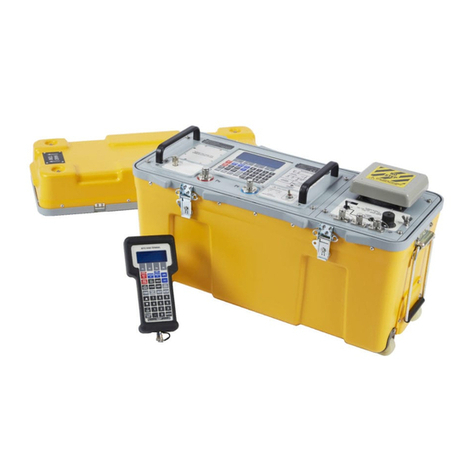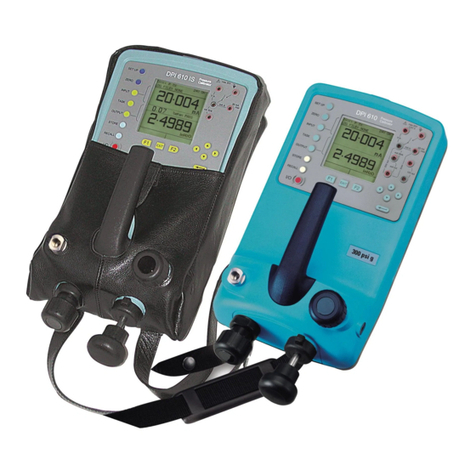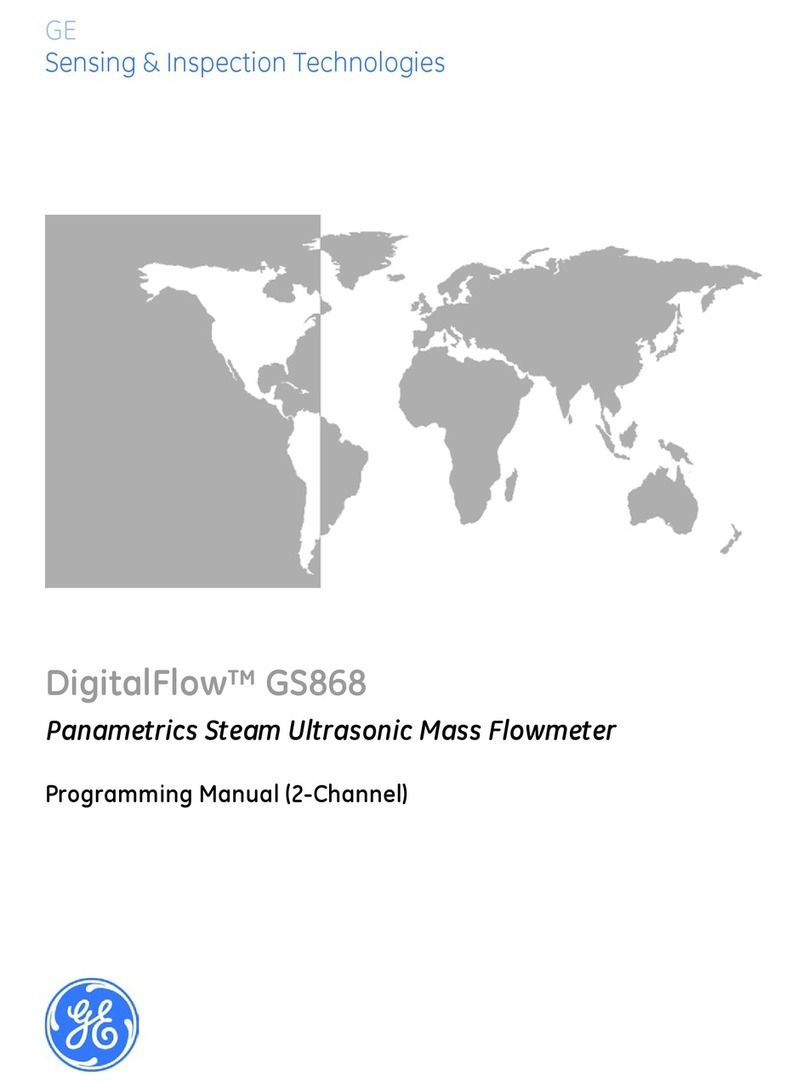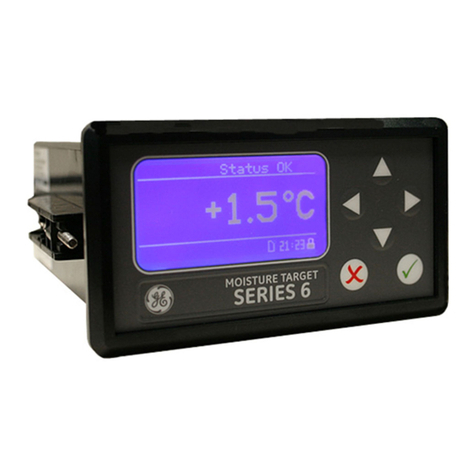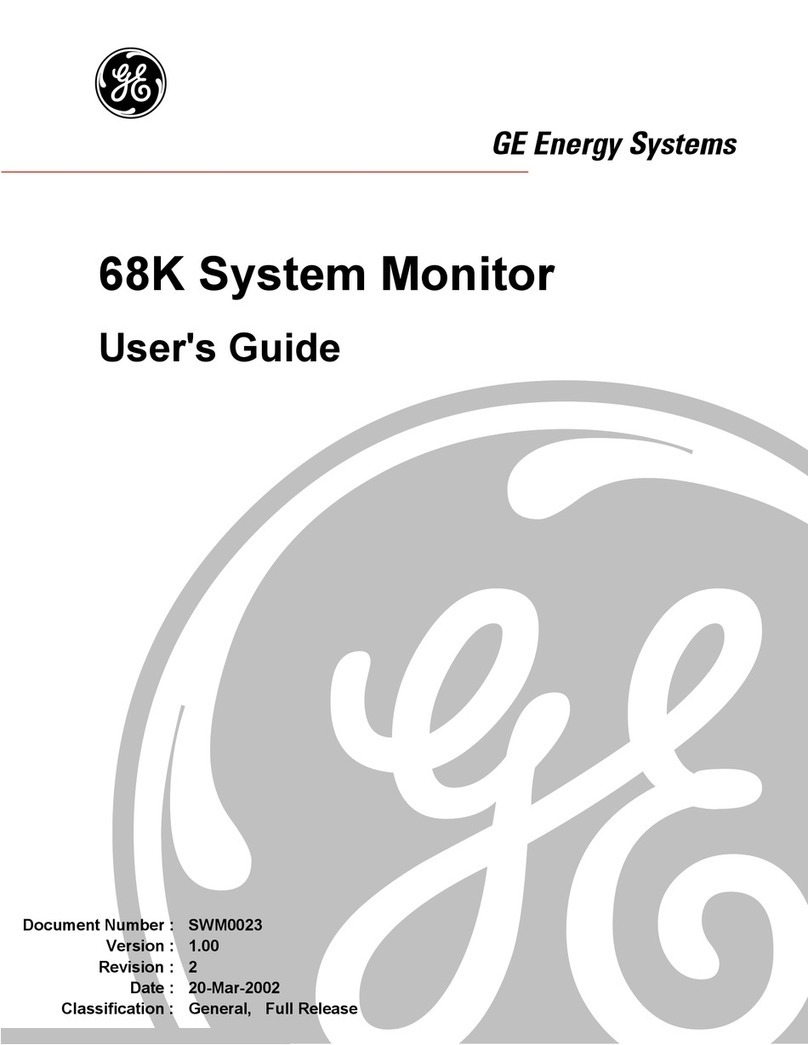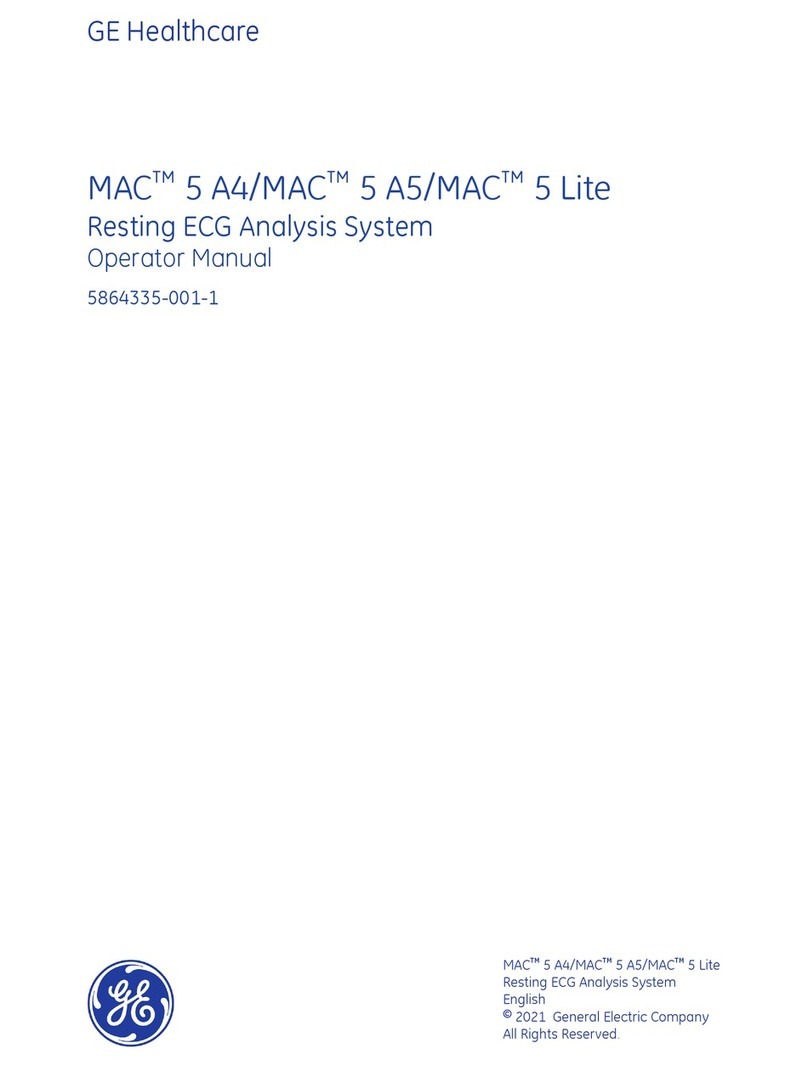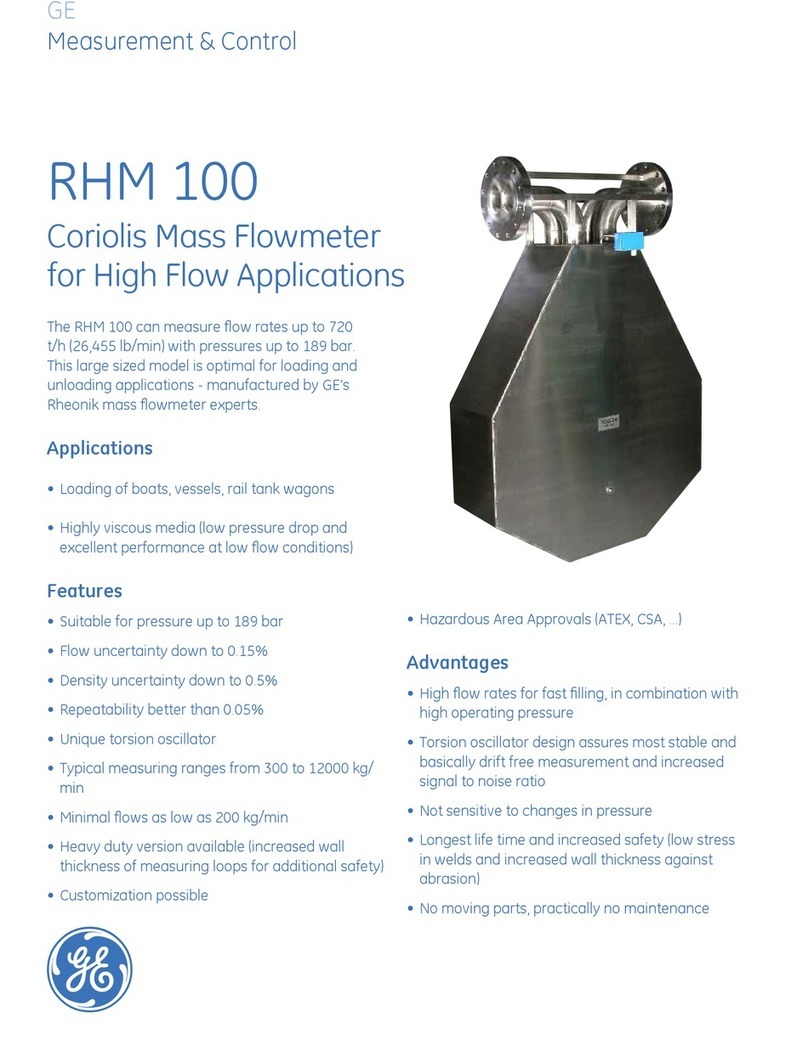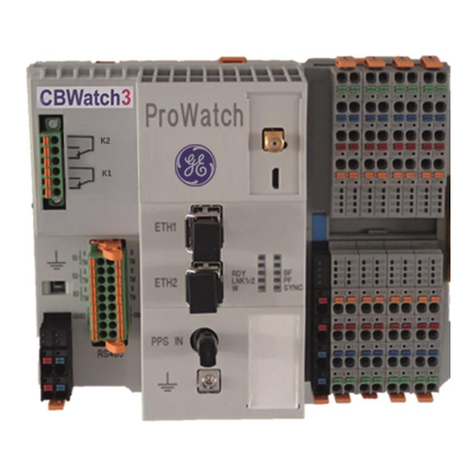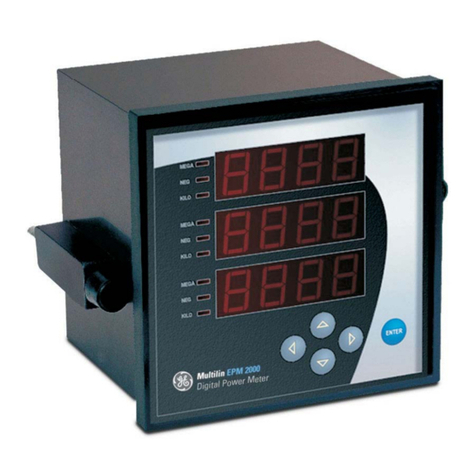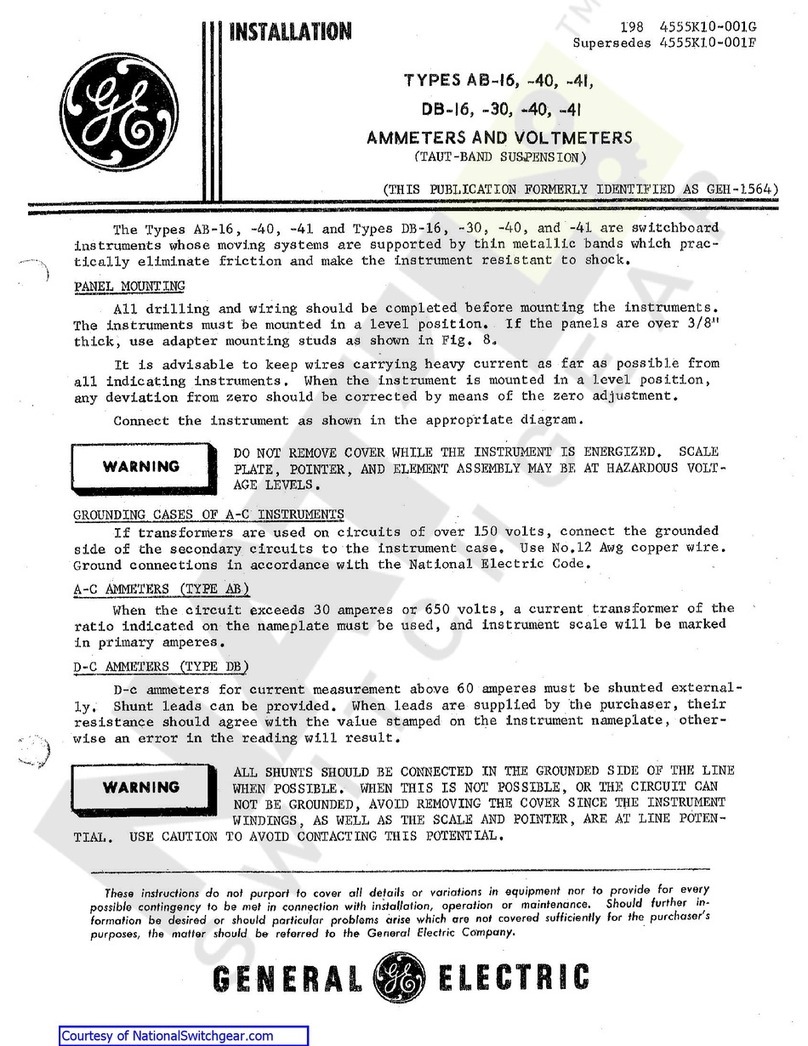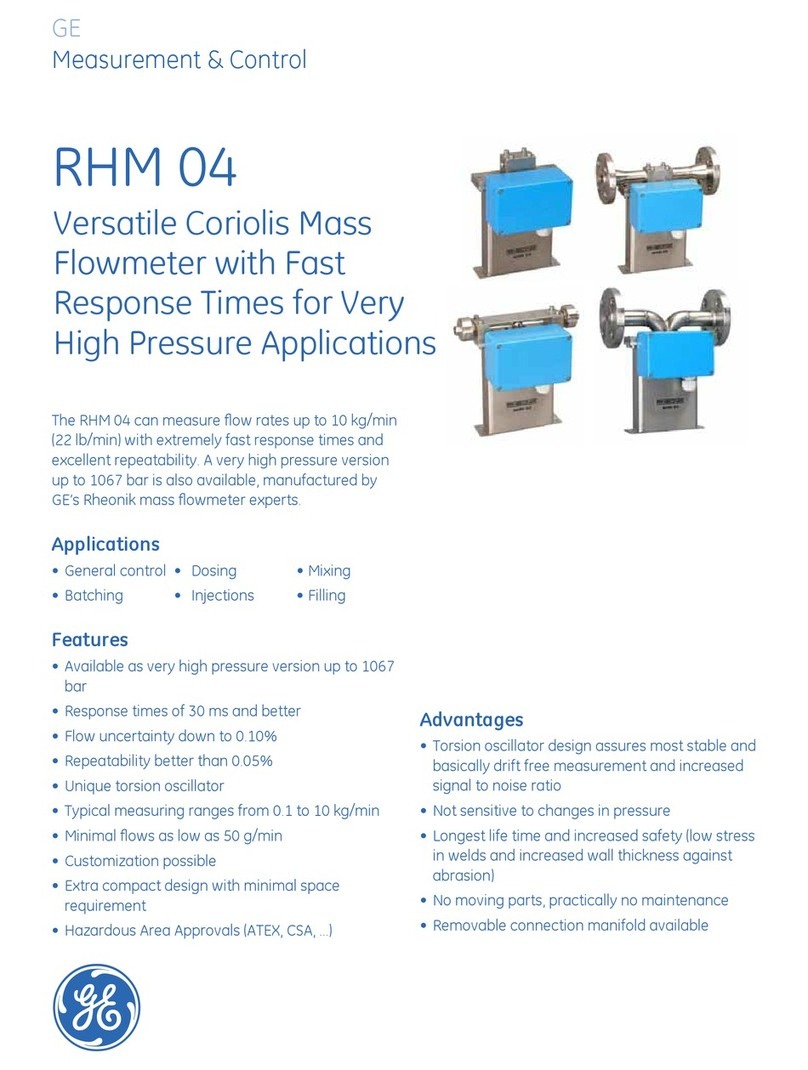
5
AMP1B1, AMP1C2, AMP1C3 Compact Power and Energy Meter
Product Diagram Wiring Diagram Symbols
To avoid distortion, use parallel wires for control power and
voltage inputs. The following symbols are used in the wiring
diagrams on the following pages.
CAUTION: RISK OF EQUIPMENT DAMAGE
• This product is designed only for use with 1V or 0.33V
current transducers (CTs).
• DO NOT USE CURRENT OUTPUT (e.g. 5A) CTs ON
THIS PRODUCT.
• Failure to follow these instructions can result in
overheating and permanent equipment damage.
Alarm Energy
CONTROL POWER
0.1A 50/60 Hz
ABCN 12
ABCAlarm Energy
NC NO + - S
OUTPUT
Common - 1 or 1/3VAC Input
-
+
-
+
-
+
IA
IB
IC
Phase Loss
Alarm
Output Varies
by Model1
Phase
VA
VB
VC
Neutral
Earth
Control
Power
UL: 90V
L-N
- 600V
L-L
CE: 90V
L-N
- 300VL-N
VOLTAGE INPUTS
CAT III 50/60 Hz
+
–
The red alarm LED lights when any of the 3 phase voltages drop below the
selected threshold: The green Energy LED lights momentarily each time the
Energy output pulse is active.
1Two Output Options Available
+ - S
VARh
VARh
Output
RS-485
Modbus
Shield
+ - S
AMP1B1 -Pulse AMP1Cx-RS-485
Wiring Diagram Symbols
To avoid distortion, use parallelwires for control power and
voltage inputs. The following symbols are used in the wiring
diagrams on the following pages.
Symbol Description
Voltage Disconnect Switch
Fuse (Installer is responsible for ensuring compliance
with local requirements. No fuses are included with
the meter.)
Earth Ground
X2
X1
Current Transducer
Potential Transformer
Protection containing a voltage disconnect switch
with a fuse or disconnect circuit breaker. The
protection device must be rated for the available
short-circuit current at the connection point.
CAUSION: RISK OF EQUIPMENT DAMAGE
• This product is designed only for use with 1V or 0.33V
current transducers (CTs).
• DO NOT USE CURRENT OUTPUT (e.g. 5A) CTs ON THIS
PRODUCT.
• Failureto follow these instructions can result in
overheating and permanent equipment damage.
Product Diagram
Alarm Energy
CONTROL POWER
0.1A 50/60 Hz
ABCN 12
ABCAlarm Energy
NC NO + - S
OUTPUT
Common - 1 or 1/3VAC Input
-
+
-
+
-
+
IA
IB
IC
Phase Loss
Alarm
Output Varies
by Model1
Phase
VA
VB
VC
Neutral
Earth
Control
Power
UL: 90V
L-N
- 600V
L-L
CE: 90V
L-N
- 300VL-N
VOLTAGE INPUTS
CAT III 50/60 Hz
+
–
The red alarm LED lights when any of the 3 phase voltages drop below the
selected threshold: The green Energy LED lights momentarily each time the
Energy output pulse is active.
1Two Output Options Available
+ - S
VARh
VARh
Output
RS-485
Modbus
Shield
+ - S
AMP1B1 -Pulse AMP1Cx-RS-485
Wiring Diagram Symbols
To avoid distortion, use parallelwires for control power and
voltage inputs. The following symbols are used in the wiring
diagrams on the following pages.
Symbol Description
Voltage Disconnect Switch
Fuse (Installer is responsible for ensuring compliance
with local requirements. No fuses are included with
the meter.)
Earth Ground
X2
X1
Current Transducer
Potential Transformer
Protection containing a voltage disconnect switch
with a fuse or disconnect circuit breaker. The
protection device must be rated for the available
short-circuit current at the connection point.
CAUSION: RISK OF EQUIPMENT DAMAGE
• This product is designed only for use with 1V or 0.33V
current transducers (CTs).
• DO NOT USE CURRENT OUTPUT (e.g. 5A) CTs ON THIS
PRODUCT.
• Failureto follow these instructions can result in
overheating and permanent equipment damage.
Product Diagram
Alarm Energy
CONTROL POWER
0.1A 50/60 Hz
ABCN 12
ABCAlarm Energy
NC NO + - S
OUTPUT
Common - 1 or 1/3VAC Input
-
+
-
+
-
+
IA
IB
IC
Phase Loss
Alarm
Output Varies
by Model1
Phase
VA
VB
VC
Neutral
Earth
Control
Power
UL: 90V
L-N
- 600V
L-L
CE: 90V
L-N
- 300VL-N
VOLTAGE INPUTS
CAT III 50/60 Hz
+
–
The red alarm LED lights when any of the 3 phase voltages drop below the
selected threshold: The green Energy LED lights momentarily each time the
Energy output pulse is active.
1Two Output Options Available
+ - S
VARh
VARh
Output
RS-485
Shield
+ - S
AMP1B1 -Pulse AMP1Cx-RS-485
Wiring Diagram Symbols
To avoid distortion, use parallelwires for control power and
voltage inputs. The following symbols are used in the wiring
diagrams on the following pages.
Symbol Description
Voltage Disconnect Switch
Fuse (Installer is responsible for ensuring compliance
with local requirements. No fuses are included with
the meter.)
Earth Ground
X2
X1
Current Transducer
Potential Transformer
Protection containing a voltage disconnect switch
with a fuse or disconnect circuit breaker. The
protection device must be rated for the available
short-circuit current at the connection point.
CAUSION: RISK OF EQUIPMENT DAMAGE
• This product is designed only for use with 1V or 0.33V
current transducers (CTs).
• DO NOT USE CURRENT OUTPUT (e.g. 5A) CTs ON THIS
PRODUCT.
• Failureto follow these instructions can result in
overheating and permanent equipment damage.
The red alarm LED lights when any of the 3 phase voltages drop below the selected
threshold: The green Energy LED lights momentarily each time the Energy output pulse
is active.
1Two Output Options Available
AMP1B1 - Pulse AMP1Cx - RS-485
Two 5-character
rows of display text.
• Top row
alphanumeric
• Bottom row
numeric only
Symbol Description
Voltage Disconnect Switch
Fuse (Installer is responsible for ensuring compliance
with local requirements. No fuses are included with
the meter.)
Earth Ground
Current Transducer
Potential Transformer
Protection containing a voltage disconnect switch
with a fuse or disconnect circuit breaker. The
protection device must be rated for the available
short-circuit current at the connection point.
Product Diagram
Alarm Energy
CONTROL POWER
0.1A 50/60 Hz
ABCN 12
ABCAlarm Energy
NC NO + - S
OUTPUT
Common - 1 or 1/3VAC Input
-
+
-
+
-
+
IA
IB
IC
Phase Loss
Alarm
Output Varies
by Model1
Phase
VA
VB
VC
Neutral
Earth
Control
Power
UL: 90V
L-N
- 600V
L-L
CE: 90V
L-N
- 300VL-N
VOLTAGE INPUTS
CAT III 50/60 Hz
+
–
The red alarm LED lights when any of the 3 phase voltages drop below the
selected threshold: The green Energy LED lights momentarily each time the
Energy output pulse is active.
1Two Output Options Available
+ - S
VARh
VARh
Output
RS-485
Modbus
Shield
+ - S
AMP1B1 -Pulse AMP1Cx-RS-485
Wiring Diagram Symbols
To avoid distortion, use parallelwires for control power and
voltage inputs. The following symbols are used in the wiring
diagrams on the following pages.
Symbol Description
Voltage Disconnect Switch
Fuse (Installer is responsible for ensuring compliance
with local requirements. No fuses are included with
the meter.)
Earth Ground
X2
X1
Current Transducer
Potential Transformer
Protection containing a voltage disconnect switch
with a fuse or disconnect circuit breaker. The
protection device must be rated for the available
short-circuit current at the connection point.
CAUSION: RISK OF EQUIPMENT DAMAGE
• This product is designed only for use with 1V or 0.33V
current transducers (CTs).
• DO NOT USE CURRENT OUTPUT (e.g. 5A) CTs ON THIS
PRODUCT.
• Failureto follow these instructions can result in
overheating and permanent equipment damage.
Product Diagram
Alarm Energy
CONTROL POWER
0.1A 50/60 Hz
ABCN 12
ABCAlarm Energy
NC NO + - S
OUTPUT
Common - 1 or 1/3VAC Input
-
+
-
+
-
+
IA
IB
IC
Phase Loss
Alarm
Output Varies
by Model1
Phase
VA
VB
VC
Neutral
Earth
Control
Power
UL: 90V
L-N
- 600V
L-L
CE: 90V
L-N
- 300VL-N
VOLTAGE INPUTS
CAT III 50/60 Hz
+
–
The red alarm LED lights when any of the 3 phase voltages drop below the
selected threshold: The green Energy LED lights momentarily each time the
Energy output pulse is active.
1Two Output Options Available
+ - S
VARh
VARh
Output
RS-485
Modbus
Shield
+ - S
AMP1B1 -Pulse AMP1Cx-RS-485
Wiring Diagram Symbols
To avoid distortion, use parallelwires for control power and
voltage inputs. The following symbols are used in the wiring
diagrams on the following pages.
Symbol Description
Voltage Disconnect Switch
Fuse (Installer is responsible for ensuring compliance
with local requirements. No fuses are included with
the meter.)
Earth Ground
X2
X1
Current Transducer
Potential Transformer
Protection containing a voltage disconnect switch
with a fuse or disconnect circuit breaker. The
protection device must be rated for the available
short-circuit current at the connection point.
CAUSION: RISK OF EQUIPMENT DAMAGE
• This product is designed only for use with 1V or 0.33V
current transducers (CTs).
• DO NOT USE CURRENT OUTPUT (e.g. 5A) CTs ON THIS
PRODUCT.
• Failureto follow these instructions can result in
overheating and permanent equipment damage.
Product Diagram
Alarm Energy
CONTROL POWER
0.1A 50/60 Hz
ABCN 12
ABCAlarm Energy
NC NO + - S
OUTPUT
Common - 1 or 1/3VAC Input
-
+
-
+
-
+
IA
IB
IC
Phase Loss
Alarm
Output Varies
by Model1
Phase
VA
VB
VC
Neutral
Earth
Control
Power
UL: 90V
L-N
- 600V
L-L
CE: 90V
L-N
- 300VL-N
VOLTAGE INPUTS
CAT III 50/60 Hz
+
–
The red alarm LED lights when any of the 3 phase voltages drop below the
selected threshold: The green Energy LED lights momentarily each time the
Energy output pulse is active.
1Two Output Options Available
+ - S
VARh
VARh
Output
RS-485
Modbus
Shield
+ - S
AMP1B1 -Pulse AMP1Cx-RS-485
Wiring Diagram Symbols
To avoid distortion, use parallelwires for control power and
voltage inputs. The following symbols are used in the wiring
diagrams on the following pages.
Symbol Description
Voltage Disconnect Switch
Fuse (Installer is responsible for ensuring compliance
with local requirements. No fuses are included with
the meter.)
Earth Ground
X2
X1
Current Transducer
Potential Transformer
Protection containing a voltage disconnect switch
with a fuse or disconnect circuit breaker. The
protection device must be rated for the available
short-circuit current at the connection point.
CAUSION: RISK OF EQUIPMENT DAMAGE
• This product is designed only for use with 1V or 0.33V
current transducers (CTs).
• DO NOT USE CURRENT OUTPUT (e.g. 5A) CTs ON THIS
PRODUCT.
• Failureto follow these instructions can result in
overheating and permanent equipment damage.
Product Diagram
Alarm Energy
CONTROL POWER
0.1A 50/60 Hz
ABCN 12
ABCAlarm Energy
NC NO + - S
OUTPUT
Common - 1 or 1/3VAC Input
-
+
-
+
-
+
IA
IB
IC
Phase Loss
Alarm
Output Varies
by Model1
Phase
VA
VB
VC
Neutral
Earth
Control
Power
UL: 90V
L-N
- 600V
L-L
CE: 90V
L-N
- 300VL-N
VOLTAGE INPUTS
CAT III 50/60 Hz
+
–
The red alarm LED lights when any of the 3 phase voltages drop below the
selected threshold: The green Energy LED lights momentarily each time the
Energy output pulse is active.
1Two Output Options Available
+ - S
VARh
VARh
Output
RS-485
Modbus
Shield
+ - S
AMP1B1 -Pulse AMP1Cx-RS-485
Wiring Diagram Symbols
To avoid distortion, use parallelwires for control power and
voltage inputs. The following symbols are used in the wiring
diagrams on the following pages.
Symbol Description
Voltage Disconnect Switch
Fuse (Installer is responsible for ensuring compliance
with local requirements. No fuses are included with
the meter.)
Earth Ground
X2
X1
Current Transducer
Potential Transformer
Protection containing a voltage disconnect switch
with a fuse or disconnect circuit breaker. The
protection device must be rated for the available
short-circuit current at the connection point.
CAUSION: RISK OF EQUIPMENT DAMAGE
• This product is designed only for use with 1V or 0.33V
current transducers (CTs).
• DO NOT USE CURRENT OUTPUT (e.g. 5A) CTs ON THIS
PRODUCT.
• Failureto follow these instructions can result in
overheating and permanent equipment damage.
Product Diagram
Alarm Energy
CONTROL POWER
0.1A 50/60 Hz
ABCN 12
ABCAlarm Energy
NC NO + - S
OUTPUT
Common - 1 or 1/3VAC Input
-
+
-
+
-
+
IA
IB
IC
Phase Loss
Alarm
Output Varies
by Model1
Phase
VA
VB
VC
Neutral
Earth
Control
Power
UL: 90V
L-N
- 600V
L-L
CE: 90V
L-N
- 300VL-N
VOLTAGE INPUTS
CAT III 50/60 Hz
+
–
The red alarm LED lights when any of the 3 phase voltages drop below the
selected threshold: The green Energy LED lights momentarily each time the
Energy output pulse is active.
1Two Output Options Available
+ - S
VARh
VARh
Output
RS-485
Modbus
Shield
+ - S
AMP1B1 -Pulse AMP1Cx-RS-485
Wiring Diagram Symbols
To avoid distortion, use parallelwires for control power and
voltage inputs. The following symbols are used in the wiring
diagrams on the following pages.
Symbol Description
Voltage Disconnect Switch
Fuse (Installer is responsible for ensuring compliance
with local requirements. No fuses are included with
the meter.)
Earth Ground
X2
X1
Current Transducer
Potential Transformer
Protection containing a voltage disconnect switch
with a fuse or disconnect circuit breaker. The
protection device must be rated for the available
short-circuit current at the connection point.
CAUSION: RISK OF EQUIPMENT DAMAGE
• This product is designed only for use with 1V or 0.33V
current transducers (CTs).
• DO NOT USE CURRENT OUTPUT (e.g. 5A) CTs ON THIS
PRODUCT.
• Failureto follow these instructions can result in
overheating and permanent equipment damage.
Product Diagram
Alarm Energy
CONTROL POWER
0.1A 50/60 Hz
ABCN 12
ABCAlarm Energy
NC NO + - S
OUTPUT
Common - 1 or 1/3VAC Input
-
+
-
+
-
+
IA
IB
IC
Phase Loss
Alarm
Output Varies
by Model1
Phase
VA
VB
VC
Neutral
Earth
Control
Power
UL: 90V
L-N
- 600V
L-L
CE: 90V
L-N
- 300VL-N
VOLTAGE INPUTS
CAT III 50/60 Hz
+
–
The red alarm LED lights when any of the 3 phase voltages drop below the
selected threshold: The green Energy LED lights momentarily each time the
Energy output pulse is active.
1Two Output Options Available
+ - S
VARh
VARh
Output
RS-485
Modbus
Shield
+ - S
AMP1B1 -Pulse AMP1Cx-RS-485
Wiring Diagram Symbols
To avoid distortion, use parallelwires for control power and
voltage inputs. The following symbols are used in the wiring
diagrams on the following pages.
Symbol Description
Voltage Disconnect Switch
Fuse (Installer is responsible for ensuring compliance
with local requirements. No fuses are included with
the meter.)
Earth Ground
X2
X1
Current Transducer
Potential Transformer
Protection containing a voltage disconnect switch
with a fuse or disconnect circuit breaker. The
protection device must be rated for the available
short-circuit current at the connection point.
CAUSION: RISK OF EQUIPMENT DAMAGE
• This product is designed only for use with 1V or 0.33V
current transducers (CTs).
• DO NOT USE CURRENT OUTPUT (e.g. 5A) CTs ON THIS
PRODUCT.
• Failureto follow these instructions can result in
overheating and permanent equipment damage.












